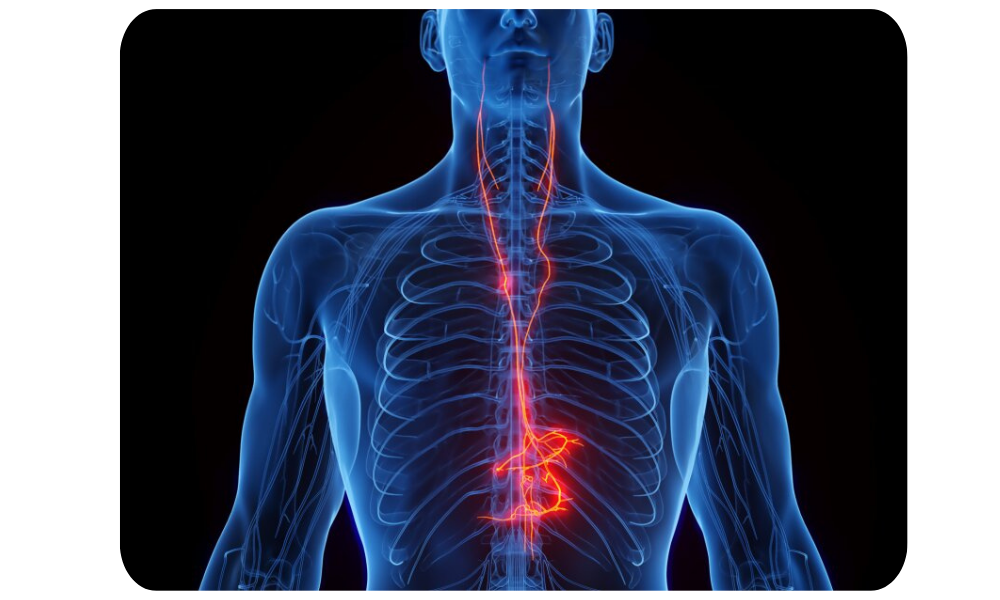The vagus nerve is one of the most important nerves in the body, responsible for many functions related to the parasympathetic nervous system. This nerve has a major role in regulating heart rate, digestion, respiration, and immune system response. It is also involved in the relaxation response, which helps the body recover from stress.
Let’s explore the vagus nerve’s role in the body and how physical therapy can help restore its function.
What is the vagus nerve?
The vagus nerve is the longest cranial nerve in the body, extending from the brainstem to the abdomen. It is divided into two branches, the dorsal and ventral vagus nerves. The dorsal vagus nerve is responsible for the body’s relaxation response, slowing the heart rate and reducing stress. The ventral vagus nerve, on the other hand, is involved in social engagement and bonding, promoting relaxation and calmness.
The vagus nerve is a major player in the parasympathetic nervous system, which is responsible for calming the body down after a stressful event. When this system is activated, the heart rate slows, the digestive system is stimulated, and the body is prepared for rest and relaxation.

What Happens When the Vagus Nerve is Dysfunctional?
When the vagus nerve is dysfunctional, it can lead to a variety of health problems. Dysfunction can occur when the nerve is compressed or damaged, leading to poor communication with the organs it is responsible for regulating. This can lead to problems with digestion, heart rate, and immune system function.
Some common symptoms of vagus nerve dysfunction include:
- Rapid heart rate
- Digestive problems, including constipation and irritable bowel syndrome (IBS)
- Anxiety and depression
- Inflammatory conditions, such as rheumatoid arthritis and Crohn’s disease
One of the most common effects of vagus nerve dysfunction is altered breathing patterns and muscle tension, which can lead to musculoskeletal pain. When the vagus nerve is not functioning properly, the body’s natural response to stress is compromised, and the sympathetic nervous system, responsible for the “fight or flight” response, is activated.
This activation of the sympathetic nervous system can lead to shallow, rapid breathing and tension in the muscles. Over time, this altered breathing pattern and muscle tension can lead to chronic musculoskeletal pain, particularly in the neck, shoulders, and back. The body’s natural ability to relax and recover from stress is impaired, leading to a cycle of pain and tension.
Physical therapy can be an effective way to break this cycle of pain and tension. By restoring the function of the parasympathetic nervous system, physical therapy can help to reduce stress and promote relaxation, which can help to relieve musculoskeletal pain. By using manual therapy techniques, such as myofascial release and craniosacral therapy, physical therapists can release tension in the muscles and improve the function of the vagus nerve, reducing pain and promoting relaxation.
Additionally, physical therapists can work with patients to identify any postural and movement patterns that may be contributing to their pain. By addressing these patterns through exercise and movement, physical therapy can help patients to improve their posture and movement mechanics, reducing the risk of future musculoskeletal pain.
How else can Physical Therapy help?
Physical therapy can play an important role in restoring the function of the vagus nerve through manual therapy. Manual therapy techniques can be used to improve the function of the parasympathetic system, reducing stress and promoting relaxation. The following are some of the techniques that may be used in physical therapy to help restore vagus nerve function.
- Deep Breathing: Deep breathing exercises can stimulate the parasympathetic nervous system and promote relaxation. Physical therapists may teach patients how to perform diaphragmatic breathing, which involves breathing deeply into the belly and exhaling slowly.
- Myofascial Release: Myofascial release is a manual therapy technique that targets the fascia, the connective tissue that surrounds muscles and organs. By releasing tension in the fascia, myofascial release can help improve the function of the vagus nerve and promote relaxation.
- Craniosacral Therapy: Craniosacral therapy is a gentle manual therapy technique that focuses on the skull and sacrum. By releasing tension in the skull and spine, craniosacral therapy can help improve the function of the nervous system and reduce stress.
- Visceral Manipulation: Visceral manipulation is a manual therapy technique that targets the organs of the body. By gently manipulating the organs, visceral manipulation can help improve the function of the vagus nerve and promote relaxation.
In addition to these manual therapy techniques, physical therapists may also use exercise and movement to help restore vagus nerve function. For example, yoga and tai chi can be effective ways to promote relaxation and reduce stress. By combining manual therapy techniques with exercise and movement, physical therapy can provide a comprehensive approach to restoring vagus nerve function and improving overall health.
In conclusion, the vagus nerve plays a critical role in the parasympathetic nervous system, which is responsible for reducing stress and promoting relaxation. When the vagus nerve is dysfunctional, altered breathing patterns and muscle tension can lead to chronic musculoskeletal pain. Physical therapy can help to restore vagus nerve function and reduce musculoskeletal pain through manual therapy techniques, exercise and movement interventions. If you are experiencing chronic pain, it may be worth seeking out the help of a physical therapist who can assess your condition and develop a personalized treatment plan to help you restore your body’s natural ability to relax and recover from stress.




